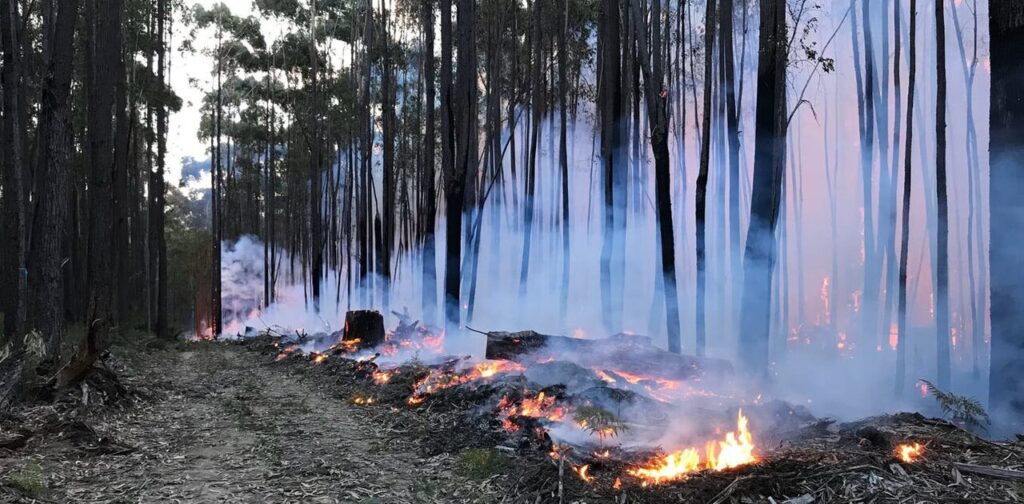For anyone who loves wild animals and the forests they call home, the increasing frequency and intensity of wildfires in the western United States is deeply alarming. From California to Oregon to Washington, forest fires threaten not only human communities but entire ecosystems. In response, a common approach has emerged: “managing” forests by thinning trees, reducing fuel loads, and using controlled burns or herbicides.
But a growing debate among scientists, conservationists, and foresters calls into question whether these industrial treatments are truly the best—or even the safest—way to restore forest health and protect wildlife.
The Logic Behind Forest “Management”
Forest management initiatives often emphasize thinning, controlled burns, and chemical treatments to reduce the density of vegetation and “fuel” for fires. Agencies argue that these measures prevent catastrophic wildfires and protect nearby communities. Some commonly used techniques include:
- Chainsaws and masticators: Removing small trees and underbrush to limit flammable material.
- Controlled burns (prescribed fire): Intentionally setting small fires under controlled conditions to consume excess fuel.
- Herbicide treatments: Suppressing fast-growing plants that can fuel wildfires.
Proponents say these practices reduce wildfire severity and help forests remain resilient in the face of climate change-driven heatwaves and drought. Homeowners near forests are often encouraged to create defensible space and clear brush to protect their properties from fire risk.
The Scientific Controversy
While the logic seems straightforward, many ecologists and wildlife advocates caution that industrial “forest thinning” can cause more harm than good.
Degradation of Forest Ecosystems
According to scientists like Richard W. Halsey of the California Chaparral Institute, heavy machinery and chemical treatments can damage soils, reduce biodiversity, and disrupt natural processes that help forests recover after fire. Chainsaws and masticators not only remove vegetation but also compact soil, making it harder for native plants to regenerate. Herbicides can kill non-target species and reduce the availability of food and shelter for wildlife.
Misconceptions About Fire
Another key debate centers on the role of wildfire itself. Contrary to the common narrative that fires “destroy” forests, research shows that many ecosystems are adapted to periodic fires, which help recycle nutrients, clear invasive species, and stimulate regeneration. Prescribed burns, if poorly executed, can actually mimic destructive wildfires rather than supporting natural forest cycles.
Wildlife Impacts
Jack Gescheidt of In Defense of Animals and Fleur Dawes from The TreeSpirit Project emphasize that thinning forests for fire prevention often displaces wildlife, destroys nesting sites, and fragments habitats. Species that rely on dense forest cover—such as songbirds, small mammals, and forest-floor reptiles—can be severely impacted. Removing vegetation may make forests temporarily “safer” for humans, but it increases stress and mortality for animals that cannot escape these changes.
Balancing Human Safety and Forest Health
This debate is not about ignoring wildfire danger—it’s about rethinking the methods we use. Many scientists argue that protecting human communities can be done without degrading ecosystems:
- Fire-adapted landscaping near homes: Creating defensible spaces immediately around structures rather than industrially thinning entire forests.
- Restoring natural fire regimes: Allowing low-intensity, natural fires to maintain ecological balance without relying heavily on machinery.
- Community preparedness and evacuation planning: Ensuring that people are safe without compromising forests or wildlife.
- Ecological restoration: Planting native species and removing invasive plants manually or selectively, rather than applying widespread herbicides.
The goal is to create resilient forests and safe human habitats simultaneously, instead of choosing one at the expense of the other.
What Homeowners Can Do
For those living near forested areas in California, Oregon, or Washington, there are practical steps to reduce wildfire risk without harming ecosystems:
- Create defensible space: Clear flammable material within 30 feet of your home.
- Use fire-resistant landscaping: Plant species that are less prone to ignite and maintain moisture levels.
- Maintain access routes: Ensure driveways and roads are clear for evacuation and emergency access.
- Stay informed: Keep track of local wildfire warnings and evacuation plans.
Educating neighbors and communities about sustainable fire prevention methods helps reduce both human and wildlife casualties during wildfire season.
A Call for Sustainable Solutions
The debate over forest management highlights a deeper issue: how humans intervene in natural systems. Industrial “solutions” like heavy thinning and chemical treatment often treat forests as commodities rather than living ecosystems. By contrast, approaches that emphasize ecological balance, habitat protection, and natural fire cycles can support both wildlife and human safety.
In a world increasingly affected by climate change, wildfires are becoming more frequent and intense. Our responses must prioritize ecosystem integrity, respect wildlife, and incorporate science-backed strategies that reduce risk without destroying the very forests we aim to protect.
For more on the intersection of environmental policy, climate, and human action, explore Sustainable Action Now’s climate section.
Wildfire management is complex. The choice is not simply between letting fires burn or industrially thinning forests. By embracing holistic, ecologically sensitive methods, we can protect homes, communities, and wildlife while preserving the forests we love.
The forests are resilient—but only if humans act wisely, balancing safety, conservation, and the long-term health of the ecosystems we depend on.


